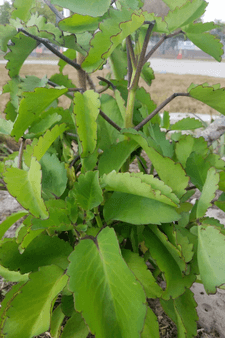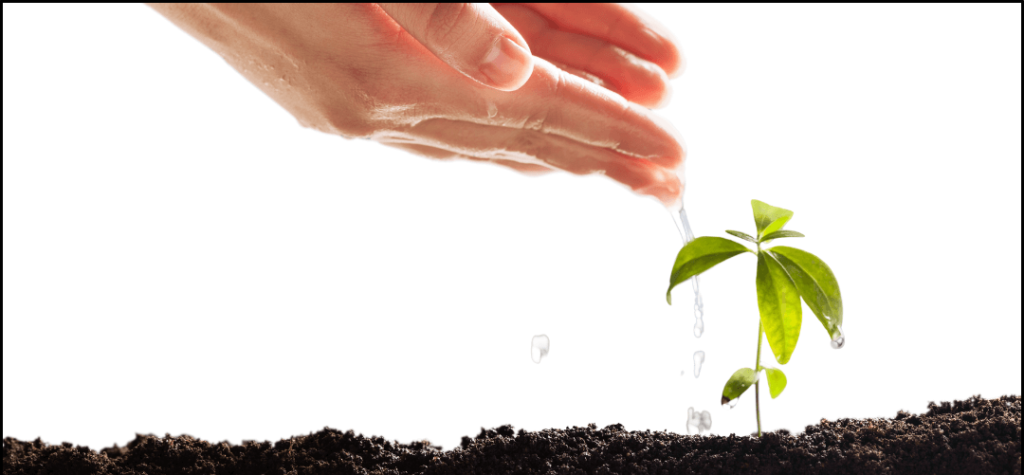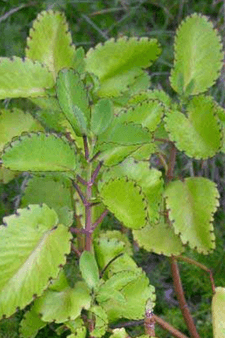Phyllanthus is filled in tropical and subtropical environments around the world. It’s accessible as a dietary enhancement. Its leaves, stems, and roots can be utilised to make teas, colours, and concentrates. It is accepted to forestall or treat a broad scope of ailments. Continue reading to find out what the 47 best health benefits of leaf of life plant are.
What Is The Leaf Of Life?
Jamaicans have relied on the Leaf of Life to cure bronchial-related ailments for ages. As a result of its widespread use on the island and growing interest from the scientific community in its possible renal advantages, it has become more popular.
Originally from Madagascar, Bryophyllum pinnatum, also known as Miracle Leaf, Air Plant, Cathedral Bells, Life Plant, and the Goethe Plant, is a common houseplant that has spread to other tropical, subtropical regions as a naturalised species. It belongs to the Crassulaceae family of plants.

In dry areas or soil conditions, the plant portions are thick and fleshy, which helps to retain water. Antibacterial, antimicrobial, antiviral, antihistamine, antifungal, and anaphylactic characteristics are all possessed by the plant in question.
High blood pressure, headaches, abscesses, and swellings may all be treated with it. Menstrual cramps, asthma, and sinus problems may be alleviated by drinking tea from the stem and leaves.
Toxins from the intestines and the bladder are flushed out
with regular use. Leaf of Life (Bryophyllum calycinum) is an exceptional plant that flourishes in every environment. It is rejuvenating on its own and capable of producing roots in its most barren situations. Putting forth Life in profusion without bounds, this persistent plant is a picture of where humans are headed as the reality of our Nutrition and Agriculture business unravels at the seams.
Leaf of Life, LLC is an effort focused on promoting organic and holistically living decisions, a refreshing and rewarding goal in the lives of individuals we come into touch with. Even as the plant is motivated to survive and generate possibilities for itself, we present choices for the person to increase their standard of living via the sale of organic and natural goods for the physical, mind, and soul.
Leaf of Life Plant Facts
The plant is indigenous to Madagascar, although it is grown in many tropical countries, including Jamaica. Asthma, coughs, shortness of breath, colds, and bronchitis are all frequent ailments for which it is used as a natural remedy. It is frequently taken as a tea, mixed in drinks, or eaten raw.
History
Due to its green fleshy look and native habitat in Madagascar, the Leaf of Life love-bush symbolises Life’s regenerative ability. With its luscious qualities, it nourishes our Life.
Cathedral Bells, a wild plant found in the Caribbean, Indian subcontinent, Brazil, and the United States, is widely distributed. Succulent and perennial, it may reach a height of two meters. When a leaf falls backwards, a new plant grows from it. Retaining water during dry periods adapts and is a sponge to water stress. The seed for a cathedral bell is a tiny black dot on the plant.
The leaves of this plant have jagged edges, and the flower appears at the very top of the stalk. They come in various hues, including pink, red, purple, and greenish hues, and they bloom throughout the early and late seasons of the year.
To meet the needs of the pharmaceutical and cosmetic industries, investors have begun cultivating this plant on a large scale. Madagascar’s Bryophyllum pinnatum is a species of Bryophyllum.
Southern Africa is also home to the plant. As well as in Macaroonsia and New Zealand, it grows throughout Asia in places like Nepal and Thailand as well as Pakistan and Egypt, in Brazil and Polynesia, in areas like Galapagos, and the West Indies.
It flourishes in the Khasi Hills, Kashmir, and Himalayan regions of India. Kerala, Tamil Nadu and Andhra Pradesh are the states in which the plant is cultivated. It is grown all over the world due to its many health benefits.
Traditional Medicine In The Face Of Toxicity

Leaves and flowers are included. Kalanchoe pinata, like other species of the Crassulaceae family (including some members of the genera Tylecodon, Cotyledon, and Adromischus). It has also been shown to possess bufadienolide cardiac glycosides, which are similar to those found in other species of the Crassulaceae family. These are capable of causing cardiac toxicity in animals, especially grazing animals.
Bryophyllum pinnatum is a plant that has been documented as being used in Trinidad and Tobago as traditional therapy for high blood pressure.
In the traditional system of medicine, the liquid of the leaf is also used to treat kidney stones. Even though there is a current study and some empirical evidence to support this usage, more research is needed to confirm this. Kalanchoe pinnata, also known as Zeb market in the French Antilles, treat headaches by applying them topically to the head.
People living in the Amazon have many different applications for KalanchoeKalanchoe. For the Creole people who live in the Amazon, roasted yucca is used as an infusion to treat inflammation and cancer. Palikur people of Brazil and French Guiana use a combination of the juice from KalanchoeKalanchoe leaves and coconut oil to treat migraines.
Constituents Of Chemical Composition
Bryophillin A, bersaldegenin-3-acetate, and cryophilic C are examples of bufadienolide chemicals that have been isolated from Bryophyllum pinnatum. Bryophillin C was shown to have insecticidal effects as well.
According to phytochemistry, Kalanchoe pinnata has a wide range of compounds, including tetraterpenes, steroids, flavonoids, chalcones, taraxasterol, auroraserol, phenolic acids, caffeic acids, malic acids, oxalic acids, and ferulic acids. Bufadienolides and phenanthrene are both very hazardous chemicals that should be avoided. K. pinata has been linked to the deaths of two calves fed for 48 hours with the bacteria. The calves died of ataxia and severe cardiac arrhythmia.
Common Names
This plant’s scientific name is Kalanchoe pinata, which means “pinnated leaf.” Bryophyllum pinnatum and Cotyledon pinnata are two more names for this plant.
A variety also knows the leaf of Life of other names, including:
Air Plant
Cathedral Bells
Miracle Leaf
Life Plant
Leaf of Life
Love Bush
Live Forever
Goethe plant
A popular houseplant, the leaf of life, has been linked to a number of health advantages.
Fruit
There is a papery and membrane aspect to fruits. The seeds are contained in four thin carpels. These seeds stay within the old blooms with an Oblong-ellipsoid, smaller than a millimetre in diameter. Reproduction may be accomplished via using either the leaves or the roots of a plant.
Related: Jojote (Spanish Plum) – What Is It Exactly?
Plant Description
Long-lived perennial herbaceous life plant grows to around 1 to 2 meters tall and is upright and succulent at the same time. Besides India, Pakistan, Nepal, Brazil, and the United States are also home to this herb’s wild relatives in other countries.
The leaf of Life is connected with a variety of medical purposes. Tropic, subtropical, and warm temperate climate zones are excellent places for this plant to thrive.
It also works well in a variety of soil types, from neutral to slightly acidic to neutral alkaline. Succulent and glabrous stems are red or green and are thick, flexible, and short.

What Is The Process Through Which The Leaf Of Life Grows?
This plant may be grown all year in moderate climes and will self-produce if conditions are favourable. When a leaf falls, it causes a swarm of new Life emerges. Although they seem invasive, their roots are shallow and easily removed. To manually propagate a leaf, plant it on damp soil or gently cover it with dirt after being cut.
Flower
Clusters of flowers bloom at the apex of its stalks. The blooms range in hue from green to pink. Seven-centimetre-long, tubular pendulous blooms produce cymose panicles. They persist in a branching cluster at the top of the flower. The pedicle (stalk) measures 10–25 millimetres. The four-petal lobes are supported by a calyx tube that is only partly joined (corolla). Winter and spring are prime times for flowering.
Leaves
The leaves have a 5-25 cm length and a width of 2-12 cm. The top portions contain intricate joint leaves with 6-7 leaves contrastingly, while the lower amounts have simple leaves. Petioles (stalks) range in length from 2 to 10 cm.
Oval or narrowly oval, these leaves feature rounded tips (obtuse apices). Leaflets one and two are smaller in diameter than those three. It is common for new plants to grow from the scalloped edges of the leaves when they are separated from the parent plant.
Leaf Of Life Benefits

It is native to Africa but may be widely found in many subtropical and tropical places, including Jamaica. Africa’s Leaf of Life plant (Myriophyllum pinnatum) is an ephemeral cactus that blooms in the springtime.
Several pieces of research have shown that the plant has antibacterial, antiviral, antifungal, anti-inflammatory, detoxifying, anti-cancer, and anti-pain characteristics, among other features. Aside from that, this herb has many antihistamines and anaphylactic effects, and other benefits.
In addition, the Leaf of Life plant has already been found to have anti-diabetic qualities and the ability to act as an intestinal cleanser (see below). It has also been shown that the plant may assist in eliminating mucus from the body.
It is primarily used in Jamaica to treat respiratory disorders, including breathing difficulties, asthma, colds, coughs, bronchitis, and other respiratory infections. The plant is often consumed as tea; however, the leaf may be juiced or uncooked if it is fresh.
There has been no credible study conducted to support the usage of the Leaf of Life plant for weight reduction, as far as I am aware. However, the plant’s specific characteristics may benefit the weight-loss process. For example, the plant contains intestinal cleaning characteristics that may help rid the body of waste products, which can surely aid in weight reduction.
Furthermore, it has been shown that the plant has immune-stimulating qualities. Starting a weight reduction program might cause the immune system to become depleted due to its stress on the body. This may sometimes result in the flu or a cold. As a result, the Leaf of Life plant might help you lose weight by boosting your immune system while you are on your weight reduction program.
1. Purifies blood: The blood is purified using a miracle leaf. As a result, you’ll feel better and be healthier.
2. Juice for a chest cold: Juice three leaves by heating them. Leaf of life juice should generate 2-3 tablespoons out of this method. Add a dash of salt to taste. Consume a spoonful three times a day for as long as you need to feel better.
3. Poultice for skin ulcer, sprains, and insect stings: Using seven fresh leaves, prepare a poultice to be applied topically. Spread out the dressing evenly over the afflicted region. Daily morning and night, reapply a new layer of protection. If you use the crushed medicinal leaves of this plant topically, you will get relief from bug bites, bruises, boils, and skin ulcers.
A poultice made from crushed leaves may be applied to the outside of the body to treat sprains, pains, and earaches, for example. It is recommended that you place the backs of the leaves on open sores, cuts, and wounds to encourage healing while also helping to halt the bleeding and inhibit infection.
1. Make a poultice out of seven fresh leaves by pulverising them.
2. Apply the poultice to the afflicted area in an equal layer.
3. Fresh poultices should be applied twice a day, in the morning and at night, or as frequently as necessary.
4. Anthelmintic action: It aids in the efficient removal of worms from the gut. To get the advantages of the leaves’ decoction, drink it twice a day with honey.
5. Antipyretic property: If you are suffering from a fever, the miracle leaf will assist you in alleviating your symptoms.
6. Corrects dysentery: Combine the aqueous extracts with honey and eat it to alleviate dysentery.
7. Helps with weight management: The Bryophyllum pinnatum leaves have been shown to help people lose weight.
8. Prevents grey hair: A regular application of the magic leaf will help to prevent hair from becoming grey. Moreover, it has a beneficial impact on the condition of the scalp.
9. Good antioxidant property: Drink a cup of dried-leaf tea two or three times a day, depending on your tolerance for caffeine. In the fight against free radicals, this will help you.
10. Helpful for people with diabetes: The leaves of Bryophyllum pinnatum may help you manage your diabetes. You will observe a significant reduction in your blood sugar levels if you consume the decoction twice a day.
11. Cures constipation: If you drink the tea produced from the dried powder of the Bryophyllum pinnatum, you will find that it relieves your constipation.
12. Treat piles at home: The extract from the leaves should be consumed twice daily to get an efficient remedy for piles.
13. Good for the liver: The herb Bryophyllum pinnatum is beneficial to the health of the liver. Jaundice may be cured in a short period.
14. Treat ear pain: Applying the leaves juice to your ear can quickly remedy your ear discomfort.
15. Cure boils: Make a poultice out of a few leaves that have been crushed. This should be applied to the boils. This may be used to treat skin irritations such as redness and oedema.
16. Helps heart health: A recent study has shown that it may improve the heart’s health.
17. Treat colds and coughs: It has been shown that the juice of the leaves coupled with sugar candies may help to reduce the symptoms of common cold and cough. This may also be beneficial for persons who have asthma.
How To Make Cold And Cough Mixture With The Leaf Of Life

You’re supposed to be able to eat the leaves and extract the juices by sprinkling salt on them. In the following, I go into depth about the method I use to remove the liquids. Drink water, including the stems and leaves, every day to flush my system of mucus and garbage.
1. Warm 13 new Life leaves over a fire or stove.
2. Make the leaves juicy by rubbing them between your hands.
3. In a small saucepan, pour the juice from the lemons. It is recommended that at least six to eight spoonfuls of juice be generated.
4. Once you’ve got the honey and lime juice in the saucepan, you can start adding it.
5. Simmer for five to seven minutes on a low burner.
6. Turn off the heat and let it cool. A bottle is all that is needed to keep it safe.
7. Do this for two weeks at a time, taking a tablespoonful every three hours.
8. If necessary, take a week off and then resume your work schedule.
When I’m having digestive issues, I’ll sometimes consume the fresh leaves of the leaf of Life.
18. Anti-inflammatory property: You may significantly minimise the size of the swelling by applying the paste made from the leaves directly to the affected area.
19. Relieves stomach ache: The decoction of the leaves might provide comfort if you are suffering from stomach pain.
20. Diuretic action: The Bryophyllum pinnatum leaf juice is beneficial in the treatment of urinary issues. This is beneficial in the treatment of excessive thirst. A portion of 40-60 ml should be taken in the mornings and evenings.
21. Teething problems: There will be less pain for the first-teeth-cutting newborns as a result of this procedure
22. For hypertension: It is recommended that you use 5-10 drops of the extract from its aerial sections. It also has a positive effect.
23. Curbs leukemia: Give 5-10 drops of the aerial part’s extract twice a day or as directed by your healthcare provider. Blood cancer may be treated with it.
24. For vaginal disorders: In the event of excessive vaginal flow in women, provide 40-60 ml of a decoction containing 2-gram honey. This should be taken twice a day.
25. Treats headache: After crushing the leaves, apply them to the forehead. Headaches may be alleviated with the use of this product.
26. Aids in eye pain: Make a paste out of the leaves’ juice and apply it all over the eye. It alleviates discomfort in the white region of the eyes.
27. Treatment for wounds: Before crushing and binding the leaves around the wound, warm them slightly. It aids in healing the injury and the removal of the scar.
28. Cures bleeding diarrhoea: Prepare the juice of its leaves by mixing it with cumin seeds and twice the quantity of ghee that you would typically use. A dose of three of these per day is recommended for the patient. It regulates the flow of blood during diarrhoea.
29. Manage leucorrhoea: The decoction of the leaves should be taken twice daily by ladies who are suffering from leucorrhoea disease. It contributes to the slowing of blood flow inside the blood vessels.
30. Treats Kidney stones: If you have kidney stones, you should take 40-50 mL of the entire plant’s decoction twice a day. Additionally, you may incorporate 500 mg of shilajit and two gm. of honey into the stew before administering it. Give this twice a day for a few days, and the bile stone will go.
31. Useful in Urinary disorders: A patient with excessive thirst or a problem affecting the urinary system should get 5 ml of the juice derived from the leaves of this plant, an extremely successful and efficient method of therapy. In the event of a urinary tract illness in males, 40-60 ml of its decoction with two gm. It should be given with honey mixed in. Please take this twice a day.
32. Helpful in boils: Crush its leaves after they have been somewhat warmed. Poultice it and apply it on the troubled part. It is also effective in treating boils, redness, and oedema.
33. Prevents grey hair: The application of the miracle leaf regularly will assist in preventing the greying of hair. It has a favourable impact on the scalp’s condition.
34. Using pounded leaves, poultices are applied to the soles of the feet to assist stop the bleeding and stop the bleeding faster.
35. Treatment for dislocations, ecchymosis, and callosities is accomplished by applying leaves to the skin.
It has a long history as a herbal remedy for various ailments, including bronchial problems, and is widely available at health food stores.
36. Shortness of breath, renal failure, menstrual irregularities, asthma, coughs, bronchitis, and chest colds are just a few of the ailments that may be treated with a herbal tea prepared from the leaves of this plant.
37. This plant’s crushed medicinal leaves may be used topically in the afflicted region to ease insect bites, bruises, boils, and skin ulcers, among other conditions.
38. Applying a poultice of crushed leaves to the body’s exterior may provide relief for sprains, pains, and earaches, among other ailments.
39. It is advised that you apply the backs of the leaves to open sores, cuts, and wounds to assist in the healing process, halt the bleeding, and prevent infection from spreading.
40. The stem and leaves of this plant may be soaked in water and ingested daily to help rid the body of mucus and waste products.
41. Fresh leaves of the leaf of Life may also be used raw as a medicinal treatment for various diseases, including asthma, bronchitis, and digestive issues.
42. Arunachal Pradesh uses leaf extract to treat urinary bladder stones and fever in children who have acquired kidney stones. The leaf extract is provided on an empty stomach to the youngsters.
43. It is traditional in Sierra Leone to manufacture cough medicine from the plant’s roots.
44. Heated leaves are used to cure swellings and abscesses in Jamaican folk medicine.
45. Rheumatoid arthritis, bruising, burns, and ulcers are some conditions used to treat topically in Chinese medicine.
46. Improved sleep quality: Another research conducted on pregnant women found that those who extracted the herb in tablet form slept better and had a more relaxing impact than those who did not.
47. Aid for the digestive tract: Leaf of Life’s antibacterial characteristics, when eaten as a tea, may aid in the reduction of “bad” bacteria in the digestive system. You may make an infusion out of the stems and leaves that you can drink every day to help your immune system stay healthy and strong. It is helpful as a cleanse as it helps to remove trash and detoxify.
Learn More: The Health Benefits of Mixed Tocopherols – Uses, Side Effects & More
Leaf Of Life Tea Preparation Instructions

Shortness of breath, coughing, and colds have all been alleviated by drinking herbal tea made from the leaves of the Leaf of Life plant.
Tea steeped with the leaves has diuretic properties and may help lower high blood pressure, even though it is moderately calming in nature. Headaches may be relieved by combining crushed leaves with coconut oil, traditionally used.
Because of the succulent quality, the plant’s leaves may be harvested and kept for many days without becoming wilted. I use this tea as an alternative therapy for respiratory issues,
and I have always had positive outcomes with this combination.
Shortness of breath, menstruation issues, asthma, coughing, and a chest cold are among illnesses that may be alleviated by drinking herbal tea produced from the leaf of Life. If you have asthma, be careful to take your medicine as advised by your doctor since asthma may be fatal.
To create a fast and straightforward cup of the leaf of life tea, follow these steps:
1. Bring one cup of water to a boil, then add three life leaves and let simmer for three minutes, stirring occasionally.
2. Remove the pan from the heat and set it aside for 2 to 3 minutes.
3. Remove the tea leaves from the cup, pour the tea into the cup, and top with 1 to 2 tablespoons of organic honey to taste.
4. To make more than one cup, increase the serving size of the boiling water and the number of leaves used to make the cup.
Uses :
Never use a herbal supplement without consulting with a medical practitioner or a licensed herbalist. A skilled professional should monitor the correct dose strength and dosing frequency to ensure that they are used correctly. Before beginning, make sure there are no adverse effects from current prescriptions and no contraindications to the medication due to any prior diseases.
1. It effectively treats kidney stones and cleans the abdominal region.
2. It has purgative properties and is used to treat piles, tridosha, flatulence, dysuria, ulcers, wounds, and purify the blood.
3. It is a reasonably well-known medication for treating kidney stones and other related diseases.
4. Bryophyllum pinnatum, when combined with candy sugar, is being used to treat coughs, asthma, and colds.
5. Dysentery is one of the conditions it’s used to treat.
6. High blood pressure is treated with the help of the plant’s root.
7. It is also used to prevent any kind of heart disease.
8. Fever is treated using Bryophyllum pinnatum, a plant native to Asia.
9. Powdered rhizome is used to alleviate constipation in both children and adults.
10. Roundworms are treated using an extract from the plant Bryophyllum pinnatum (clotrimazole).
11. It is possible to treat antipyretic action with the help of an extract from the plant.
12. Ear discomfort may be relieved by using the juice of this plant as an ear drop. It is an all-natural treatment for ear discomfort.
13. The root of this plant is thought to protect the liver and is effective in treating hepatitis.
14. It is a diuretic. As a result, it helps with problematic urinating.
15. A combination of herbal green tea and this plant is employed in herbal green tea blends because of its antioxidant properties.
16. It is one of the home treatments for piles employed (Hemorrhoids).
17. Stomach pains are relieved by the leaf juice.
18. The extract is used to nourish the hair and to cure grey hair, among other things.
19. The usage of leaves is beneficial in treating digestive disorders.
20. The paste is used to treat leucorrhoea in children.
21. Jaundice may be treated using Patharchur juice, obtained fresh from the plant.
What To Do To Keep The Leaf Of Life Alive?
What You Should Do:
1. In between two sheets of wax paper, place a leaf.
2. To keep the baking parchment from sticking, lay a sheet of lined paper on top.
3. Using a heated iron, press the wax layers against the towel or paper to seal them.
4. Cut all around the leaf, keeping a small margin of baking parchment on each side to guarantee that it will remain sealed throughout the drying process.
Spiritual Uses of Leaf of Life
1. It may be utilised to bring about good fortune.
2. It has the potential to be utilised to collect the debt.
3. Love charms may be cast with the help of the leaf.
4. It may be used to solicit favours from others, get employment, and so forth.
5. It can be utilised as a kind of protection against witches.
6. It has the capability of dispelling curses.
7. This spell protects spiritual marriages.
8. It may be used to ward off any lousy eye that may come your way.
9. It has the capability of destroying spells.
10. It may be utilised to assist in your company’s growth.
Others Facts
1. As a decorative element in the garden, it is also quite effective.
2. Leaves may be harvested and kept for many days without wilting or brittle.
3. It is planted as an ornamental plant for aesthetic reasons.
Precautions
Patients on Aspirin medicine should exercise caution while consuming the decoction or fresh juice of the Bryophyllum pinnatum, as it may interfere with or diminish the drug’s effectiveness.
Care Of Leaf Of Life Plant
The mother-of-thousands (also known as Kalanchoe daigremontiana or Bryophyllum daigremontianum) is a succulent plant not often seen in garden settings. A distinctive feature that distinguishes it from other kalanchoe species is its exceedingly unique leaves, which are pretty big and bordered along the outer margins with hundreds of small leaf-like structures.
However, according to East Tennessee State University, while it is hardy in USDA plant hardiness zones 9b and above, it is seldom cultivated in home gardens since it is poisonous and lethal to small dogs. As with other succulents, mother-of-thousands require minimal maintenance, but it does need some seasonal attention to ensure that it blooms well in the spring and summer.
Things You’ll Need To Get By
1. Fertiliser with a 15-15-15 ratio
2. Gloves
3. Knife of artisanal design
4. with drainage holes measuring 6 inches in diameter
5. Compost that is free of pathogens
6. Perlite, also known as coarse sand, is a sedimentary rock.
7. Bag made of plastic
Care For Bryophyllum Daigremontianum On A Basic Level
According to the University of Missouri, most kalanchoe species have comparable maintenance needs, and the mother-of-thousands is no exception to this rule.
It will survive in dry conditions without issue, but it will look better if watered consistently. Whenever the soil seems to be dry on top, mist it with water until it drips out of the pot’s bottom.
If the bank is placed in a catch basin, empty the basin after watering to ensure that the pool does not become submerged in water. Reduce the amount of water you use in

the fall and winter, allowing the soil to dry up entirely between irrigations almost.
Even though mother-of-thousands will thrive in the absence of fertiliser, it will benefit from frequent, light doses of balanced fertiliser throughout the growing season to accelerate its development. You may feed your plants by diluting 15-15-15 water-soluble fertiliser with 1 gallon of water, according to Logee’s Plants.
Fertilise the soil every two weeks on a wet soil surface in the spring and summer when the plant is actively growing. Feeding should be discontinued in late summer to give any new growth enough time to develop before the arrival of colder weather.
Starting Bryophyllum Daigremontianum Plants
According to the Illinois Extension, leaf cuttings are the most effective propagation method for mother-of-thousands. Select a leaf that is between 2 and 4 inches in length. Wearing gloves will help keep your skin safe when you chop the leaf off with a craft blade.
The leaf should be placed on a piece of newspaper and kept in the dark, dry area for a few days or until the cut-end is totally dry. Callusing or drying the leaf-cutting will assist in preserving it from decomposing while it is being rooted in the ground.
To fill a 6-inch plastic container, use a moistened combination of half sterile soil and half perlite. Insert the cut end of the leaf-cutting into the developing mix until the bottom half of the leaf is fully covered, and then remove the cutting.
A large plastic bag should be used to cover the pot, and it should be placed in a bright but not direct sunlight location. Overwatering will cause the mother-of-thousands leaf cuttings to decay, so only water when the soil feels dry under the surface of the cuttings. Beginning about four to six weeks, look for signs of root growth.
Best Health Benefits Of Leaf Of Life Plant – Summary
Its significant usage is to treat colds, fevers, bronchial, and other respiratory difficulties. Bryophyllum pinnatum, also known as the Leaf of Life, is a succulent plant found across the island to treat colds, fevers, bronchial, and other respiratory disorders. By chewing the leaves and adding salt, you may extract the fluids from them.
Leaf of Life is a flowering plant that belongs to the Crassulaceae family. The antibacterial, antiviral, antimicrobial, antifungal, antihistamine, and anaphylactic activities of the Leaf of Life plant are well documented.
It is a herb that may be found in abundance across India. Still, it can also be found in other regions of the globe, including Pakistan, Nepal, Brazil, and the United States of America. The leaf of Life is connected with a variety of medical applications.
Cold, coughs, and even hypertension has been treated with Leaf of Life juice. Herbal tea made from the plant is beneficial in treating shortness of breath, asthma, and menstruation issues, among other conditions. Alternatively, the newly gathered leaf may be consumed uncooked to relieve some diseases.
Please Be Aware: Statements in this article is certainly not meant to address, cure, treat or even identify any disease or either been evaluated by the Food and Drug Administration. Instead, it is only for informational reasons that it is composed.
Please, you should see your doctor or a certified medical practitioner for those who have any health problem in any respect before taking any supplement you find here or elsewhere.
 | Fitweightlogy’s content writers’ team constantly contributes to writing high-quality content linked with all the best products associated with weight loss, healthy lifestyle, fitness, tips, and motivation. Furthermore, provide tips on beauty and nutrition. |
Latest Posts
Posted in
Welcome to Fitweightlogy! We are an optimum review website of all the best products associated with weight loss, healthy life, fitness, tips, and motivations. We are a quickly developing organisation given that we typically put our visitors first. A customer-focused experience has regularly been our objective, and we value our comprehensive policies, which have placed us in a domain well beyond our competitors. On this website, we assist our visitors in reaching their desired weight, appearance goals and live a healthy lifestyle, as well as save money and time by meticulously researching and evaluating the market, assessing the available products, and producing informative recommendations based on factors such as quality, availability, price and more. Furthermore, our passion is to assist you in choosing the best possible product through our product reviews.








